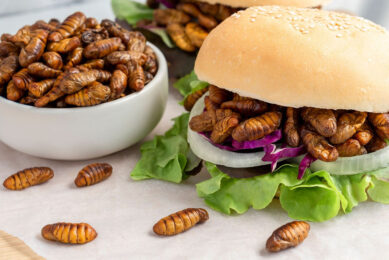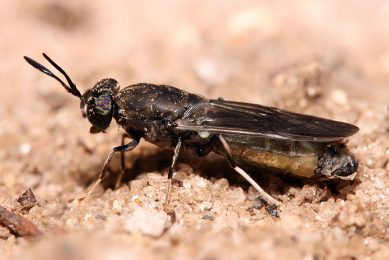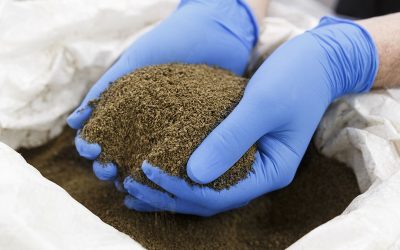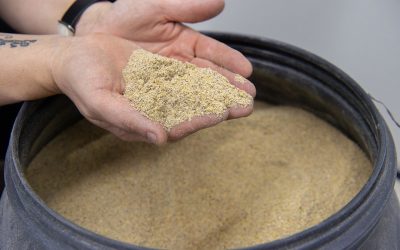Housefly larvae contribute to sustainable layer nutrition
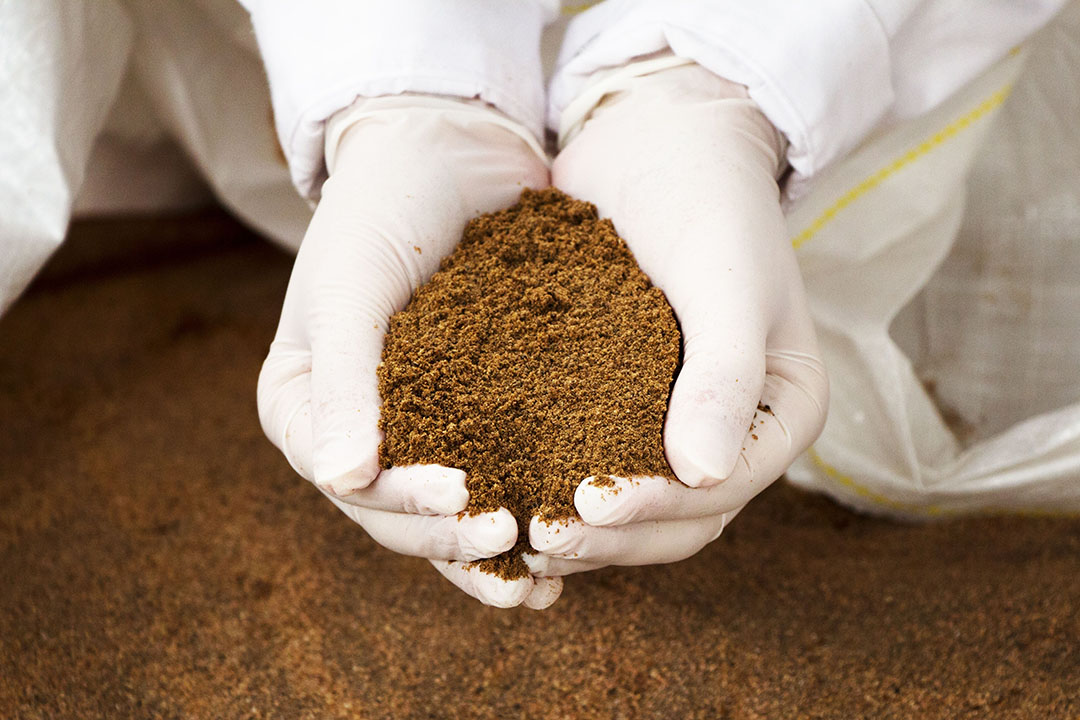
Extensive research by Schothorst Feed Research shows that housefly larvae are a viable protein source in sustainable layer nutrition which can fully replace soya.
If production of larvae can be up-scaled and implemented on layer farms, larvae will be price-competitive with soybean meal. Currently, EU legislation limits the use of larvae for poultry but this is likely to change in the future.
Growing demand for food and feed protein
The worldwide demand for protein in food and feed will increase by 1.3-1.5% per year over the next few decades. The total human population will grow to more than 8 billion people by 2030 while meat consumption per capita in developing countries is expected to increase.
Alternatives to soya as feed protein
A major source of feed protein is soya which is mainly produced in North and South America. For several reasons – less genetically modified (GMO) soya, less deforestation, more circular agriculture – EU policymakers and the feed industry are focused on reducing soya imports.
Meat meal:
One alternative could be meat meal. Further to the TSE (transmissible spongiform encephalopathies) issue in the 1980s the EU banned the use of this type of product in animal feeds.
Fish meal:
The use of fish meal as a high-quality protein source has been limited to avoid overfishing of the seas.
Insect meal:
Insects are regarded as an alternative with high potential because the production of insects demands limited amounts of water and land, and they can add value to low-value by-products.

Insects: Environmental and nutritional benefits
The large-scale production of insects can yield animal protein of high nutritional quality through the conversion of organic waste streams. Insects emit relatively small amounts of greenhouse gases and, last but not least, insects have a high nutritional value based on amino acids.
Insects: Economic feasibility
The economic feasibility of insect production will be determined by nutritional value and production costs. The production costs must, of course, be lower than the nutritional value. The nutritional value can be influenced by the insect feed and by selecting the right breeds.
Insects: What is the nutritional economic value for poultry and pigs?
Insects offer a high nutritional economic value for fish feed and pet food. Insects can replace fish meal in these products. The amino acid pattern of both products is very similar. However, the nutritional economic value of insects for poultry and pigs is much lower. Insects could be used in these products to partially replace soya, fat and synthetic amino acids.
 Can insects hold the key to safe feed?
Can insects hold the key to safe feed?
Research has shown that edible Insects can tolerate high amounts of mycotoxins. In this sense, do they offer a possible approach for grain ‘detoxification’?
Larvae production
To ensure cost-effective insect-based protein production, the ideal insect candidate should have a short reproductive cycle and be nutritious, providing high concentrations of protein and essential amino acids. To guarantee a constant supply, the ideal insect candidate should further be easy to rear under intensive conditions. Plants, animals or other organisms that do not occur naturally in a country can be harmful to nature. The ideal candidate must occur all over the world and must not pose a risk in the event of escape. The housefly meets all these criteria and would enable the cost effective production of larvae.
Ideal breeding unit
The ideal breeding unit should be fully animal friendly. Which means flies and larvae are kept under optimum light, rest and movement conditions, and have free access to feed and water. Beds should be designed in the place where the flies are to lay their eggs as a completely calm space which is particularly attractive to the females. The larvae then grow in an area where the temperature, air, feed and water are fully controlled.
Feeding larvae
Ideally the larvae are given GMP+ certified feed. Insects are also one of the major sources of anti-microbial peptides/proteins (AMPs). To be able to make optimum use of the AMP, larvae should be fed precisely as needed. The larvae feed conversion needs to be optimum to ensure that little residue remains. The positive outcome of all this is that the larvae do not need to be separated which saves greatly on costs.
Application in poultry
Poultry with access to an outdoor area pick up insects at all life stages and eat them keenly which indicates that they are evolutionarily adapted to eating insects as a natural part of their diet. The production of chitinase by poultry and pigs results in the partial digestion of chitin. This leads to the formation of N-acetyl-D glucosamines that contribute to immune modulation and reduced adherence of pathogens to cell walls. Therefore, it seems reasonable to consider the inclusion of insect proteins as a raw material in commercial feed manufacturing and to develop intensive insect farming systems for livestock. To evaluate the economic value and practical application of insects in layer feeds, the chemical composition will need to be evaluated, including fatty acids and amino acids. Coefficients for digestibility will also be required and can be based on a desk study and in vitro experiments. Restrictions on the use of insects in feed is subject to EU legislation and GMP+.
 Chickens prefer eating insect larvae meal
Chickens prefer eating insect larvae meal
A study set out to determine whether broilers displayed a preference (or not) for Tenebrio molitor mealworm by evaluating ingredient acceptability and bird performance.
Nutritional value of insects
Nutrients that predict animal performance are, above all, metabolisable energy (ME), digestible amino acids and retainable minerals. In a well-balanced feed, the cost of ME will be 65-70% of the total nutrient cost, while for digestible amino acids it will be 24-26%. Of all the 22 amino acids, lysine, methionine/cysteine, threonine, tryptophan, valine, isoleucine and arginine are regarded to be limiting in the order as stated. From the literature it appears that Amusca larvae contain less ash and more fat (Table 1). It should be noted that the fat content and fatty acid composition depends on the diet of the larvae. The protein content is similar to soybean meal. The fibre fraction in Amusca larvae is mainly chitin.
Digestibility can best be evaluated with in vivo digestibility trials. Simulation of the digestive tract by incubation of stomach conditions (pepsin/HCl) and small intestines (buffer/pancreas) may be effective. Therefore, it is useful to compare these with ingredients that are well described in feed tables. For poultry, the in vivo digestibility of insect-meal in terms of essential amino acids is 89-95%, depending on the amino acid, and is comparable to fish meal. Housefly pupae showed similar in vitro digestibility for organic material (OM) and proteins (N) compared to fish meal and poultry meal. The digestibility of pupae is normally lower compared to larvae. This can be explained by the fact that pupae contain more chitin which is less digestible for younger animals like broilers. Based on in vivo and in vitro trials, the digestibility coefficients of Amusca larvae are in the same order as CVB table values for meat meal and soybean meal (Table 2). For protein in larvae the digestibility is assumed to be higher than meat meal.
High in fat
Because of the high fat content, the ME-value of larvae is substantially higher than that of fish meal, meat meal and soybean meal. It should be noted that the fat content and fatty acid composition depends on the diet of the larvae. The price, or market value, for ME will depend on the energy prices for feed and fuel. About 68% of the ingredient costs of feed are for metabolisable energy (ME). Assuming that the price of the ingredients for a layer feed is € 210 per tonne, the price for ME (2825 kcal/kg) in the feed will be € 142 per tonne. Extrapolating this price assumption, the price for energy in larvae (4000 kcal/kg) will be € 201 per tonne. In addition, the proteins and minerals in the insects will add to their value.
Amino acid profile
The amino acid profile of insects and fish meal is similar. Compared to soybean meal, larvae are similar in lysine, threonine and valine, higher in methionine but lower in arginine, glutamine and tryptophan. Based on their amino acid profile, the larvae will be closer to fish meal in value than to soybean meal or meat meal.
Fat evaluation
For the evaluation of fat, it is necessary to consider that the crude fat fraction also contains non-fatty acid components, like glycerol, vitamins, resin and polymers. It should be noted that the fat content and fatty acid composition depends on the diet of the larvae. The fraction of fatty acids in the total fat (eluability) is 80-93%. Within the fatty acid fraction, C6-C12 may be relevant because these have anti-microbial properties. C16:0 + C18:0 are long chain saturated fatty acids and have a lower digestibility due to slow emulsification. Linoleic (Ω-6) acid and linolenic (Ω-3) acid are essential fatty acids necessary to produce relevant metabolites. Linoleic acid results in pro-inflammatory reactions while linolenic acid is anti-inflammatory. The optimum ratio is 5:1 but in many corn-soya-based diets the ratio is more than 10:1. In which event it would be better to feed omega-3 from fish oil. Compared with the fatty acid pattern of soybean meal, Amusca larvae contain less linoleic but more linolenic acid. The optimum ratio is 5.1:1 which is close to the optimum of 5, while soybean meal is much higher in linoleic acid resulting in a ratio of 7.5:1.
Use of larvae in layer feeds
Up to 25% of housefly larvae can be used in broiler diets without negative effects on performance. The performance is similar to fish meal. Housefly larvae could also replace up to 20% of fish meal in layer feeds without affecting performance and egg quality. At price levels of € 250 per tonne larvae 880 DM, the optimum inclusion rate was 18.5%. In this feed soybean meal and rapeseed meal were not price competitive and not included.
With a gradual increase in the price of larvae, the inclusion rate reduced to 5.6% at € 500 per tonne. At € 525 and above, larvae proved to be too expensive. These calculations show that it is cost effective to implement a full reduction of soybean meal with larvae prices of up to € 450 per tonne. Where insect production is carried out by the layer farmers, the maximum costs can reach € 485 when replacing all soya or € 560 when starting inclusion. In organic egg production, the use of soya is restricted to non-GMO. In that sector the use of synthetic amino acids is prohibited. This will result in a higher value for insects in this specific sector.
 Insects in feed: Sector ready to upscale
Insects in feed: Sector ready to upscale
Growing insects for feed is a sector that has grown rapidly in recent years and is ready to scale up production. Despite their many benefits, the sector seems to be on hold due to restrictions in legislation.
Price-competitive with soybean meal
If production of larvae can be up-scaled and implemented on layer farms, and costs amount to less than € 530 per tonne at farm level, larvae will be price-competitive with soybean meal and provide a high quality protein source for laying hens, along with the benefits of a sustainable on-farm circular system.
References available on request.
Authors:
Laura Star, Schothorst Feed Research
Gert Hemke, Hemke Nutri Consult




